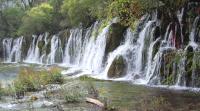
The small town Chuan-Zhu-Si 川主寺 has a new airport, about 45 min drive to 黄龙, and 90 min to 九寨沟. Every day, more than a dozen Boeing 757's fly in and then out. The flight to 成都 is only 40 minutes. However, on both directions, our flights were delayed by 3 hours. This is pretty common, not only because the bad planning of the airline dispatchers, mainly due to the weather. Altitude at 3446 m, amidst the mountain range, short runways, making the landing next to impossible in cloudy days. When we left at 11:30pm on 9/16, there were still hundreds of passengers stranded in the airport.
A cheaper alternative is bus (~¥150 instead of ¥770 each way), which follows 400 Km of mountain roads along the Min Jiang 岷江 River. 8-9 hours if everything goes smoothly. Landslide happens often, and you can be stuck for hours (as was my father last year).

We arrived at 九寨沟 at 5pm, even though we left our hotel in Chengdu just past 9am: a whole day affair to get here. Strolled to the park gate and back, bought a bottle of Tibetan barley wine 青稞扎酒, and some pancakes made of the same barley flour. We stayed at 九通 hotel (recommended by most online users) for 3 nights. Rooms are barely acceptable (¥160, I think we overpaid), but convenient: 1.5Km from the gate (one of the closest), and it shares a parking lot with the long distance bus company. It has a very nice indoor courtyard.
There're buses leaving for 黄龙 every morning at 7:10 and 8:00 (¥37). The bus has a layover of 4.5 hrs. It's possible to take the same bus back (¥40) or to get off at 川主寺 (¥20), so you can leave your bags on board.
 9/14, we arrived at Jiuzhai 九寨沟 ticket office at 6:30am. Combination ticket of ¥220 admission (students and senior ¥170) + ¥90 bus (no outside vehicles allowed in the park). We requested to come again the next day, and had our pictures printed on the tickets.
9/14, we arrived at Jiuzhai 九寨沟 ticket office at 6:30am. Combination ticket of ¥220 admission (students and senior ¥170) + ¥90 bus (no outside vehicles allowed in the park). We requested to come again the next day, and had our pictures printed on the tickets.九寨沟 is THE place to see water. Super clear, blue-green. Quiet like a mirror or roaring as in the three major waterfalls.
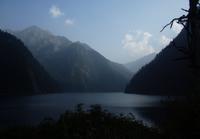 Park roads are in the form of a Y. One end is Long Lake 长海(the biggest in the park). Come here after 4pm, when everyone is gone. Otherwise, your toes may be stepped on -- yes, that many people. From here, walk down to 五彩池 5-color Pond. It's tiny, but gorgeous. The other end of the Y reaches undeveloped old growth forest. Very similar to the forest in Seattle area. Must have different species.
Park roads are in the form of a Y. One end is Long Lake 长海(the biggest in the park). Come here after 4pm, when everyone is gone. Otherwise, your toes may be stepped on -- yes, that many people. From here, walk down to 五彩池 5-color Pond. It's tiny, but gorgeous. The other end of the Y reaches undeveloped old growth forest. Very similar to the forest in Seattle area. Must have different species.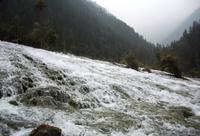 At the lower end of this branch is the beautiful pea-cock shaped 五花海 5-flower Lake (brightly colored); Pearl Shoal Falls 珍珠滩瀑布 (you can walk on the top of the falls where water jumps and glistens); and the peaceful Mirror Lake 镜海.
At the lower end of this branch is the beautiful pea-cock shaped 五花海 5-flower Lake (brightly colored); Pearl Shoal Falls 珍珠滩瀑布 (you can walk on the top of the falls where water jumps and glistens); and the peaceful Mirror Lake 镜海.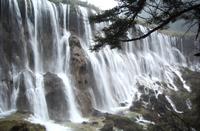 The two branches of Y connect at 诺日朗 tourist center, where you can transfer to the bus for another destination. Nothing to see in the center. Even though you can see 诺日朗瀑布 Ruorilong Falls from the bus, it's much better when you come closer.
The two branches of Y connect at 诺日朗 tourist center, where you can transfer to the bus for another destination. Nothing to see in the center. Even though you can see 诺日朗瀑布 Ruorilong Falls from the bus, it's much better when you come closer. At the trunk of the Y, the road follows the water course: many cascades, lakes. My favorite is Reed Lake 芦苇海: in between the stops, hardly anyone walk by. There's a blue strip winding in the reeds.
At the trunk of the Y, the road follows the water course: many cascades, lakes. My favorite is Reed Lake 芦苇海: in between the stops, hardly anyone walk by. There's a blue strip winding in the reeds.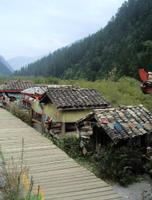 九寨沟 literally means "valley of nine villages", now three 藏 (a branch of the Tibetan) villages still exit in the park. These people are Buddhist. You can find many water mills used to turn the scripture cylinders. Colorful banners printed with words from the Buddhas, stringed together, fly high in air. It is said that every time a banner or a cylinder moves, a prayer is said.
九寨沟 literally means "valley of nine villages", now three 藏 (a branch of the Tibetan) villages still exit in the park. These people are Buddhist. You can find many water mills used to turn the scripture cylinders. Colorful banners printed with words from the Buddhas, stringed together, fly high in air. It is said that every time a banner or a cylinder moves, a prayer is said.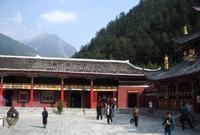 A formal temple is close to the park entrance: 扎如寺. Quite busy. They gave quick introduction and say prayers for the tourists in exchange for money. The large flat surface of the cliff in front of this temple is claimed to have segments resemble 12 zodiac animals -- all quite bogus.
A formal temple is close to the park entrance: 扎如寺. Quite busy. They gave quick introduction and say prayers for the tourists in exchange for money. The large flat surface of the cliff in front of this temple is claimed to have segments resemble 12 zodiac animals -- all quite bogus. 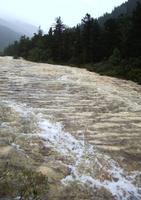 9/16, HuangLong 黄龙. We took the first bus and arrived around 10:30 am, about 0.5-1 hour ahead tour buses. It was foggy all the way, and before we arrived, it started raining.
9/16, HuangLong 黄龙. We took the first bus and arrived around 10:30 am, about 0.5-1 hour ahead tour buses. It was foggy all the way, and before we arrived, it started raining.黄龙 (¥200, students and seniors ¥150) is world's largest continuous open-air travertine formation. Grand, impressive, and colorful. Miles long golden calcium bicarbonate slope, amidst green mountain range. If it's clear, it's possible to see the snowy peak of Xuebaoding 雪宝顶 (5588m).
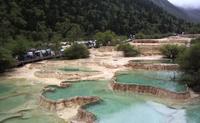 Algae and other aquatic plants' photosynthesis promotes the color and formation of the travertine ponds. These natural terraces of color are fascinating. Relentless rain and high altitude (from 3100m at the entrance to 3600m at the temple) cannot deter tourists' enthusiasm.
Algae and other aquatic plants' photosynthesis promotes the color and formation of the travertine ponds. These natural terraces of color are fascinating. Relentless rain and high altitude (from 3100m at the entrance to 3600m at the temple) cannot deter tourists' enthusiasm.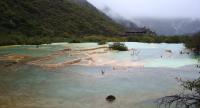 After 2.5 hr's walk on the gentle slope (~4Km), many photo shots and two stopovers for oxygen for my father (free, ¥1 breathing tube. I tried once, didn't feel any difference.), we reached the Taoist temple. The largest group of travertine ponds. Magnificent in all direction.
After 2.5 hr's walk on the gentle slope (~4Km), many photo shots and two stopovers for oxygen for my father (free, ¥1 breathing tube. I tried once, didn't feel any difference.), we reached the Taoist temple. The largest group of travertine ponds. Magnificent in all direction.By the time we exited, the sun came out! On the gravel road back, while it zigzagged towards the mountain pass of over 4000m, we drank the mountain scenery that we missed on the way in: interesting rock formations, high snowy peaks briefly including 雪宝顶, some leftover snow on the grass.
 We arrived at 川主寺 around 5pm. Bought some yak meat, had supper (some interesting dishes: local wild mushrooms, and walnut flower?).
We arrived at 川主寺 around 5pm. Bought some yak meat, had supper (some interesting dishes: local wild mushrooms, and walnut flower?).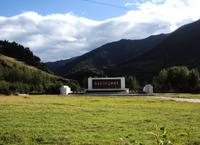 A memorial of Red Army's Long March 红军长征 was erected here in 1990. Between May and August 1936, the Red Army marched across the neighboring mountains and ravines, escaped the pursuit of the Nationalist. Even though a significant part of the troop was lost, the Communist managed to survive and kept its army, eventually (after over 10 years) kicked the Nationalist out of the mainland. Mao was also elected the head during the march.
A memorial of Red Army's Long March 红军长征 was erected here in 1990. Between May and August 1936, the Red Army marched across the neighboring mountains and ravines, escaped the pursuit of the Nationalist. Even though a significant part of the troop was lost, the Communist managed to survive and kept its army, eventually (after over 10 years) kicked the Nationalist out of the mainland. Mao was also elected the head during the march.